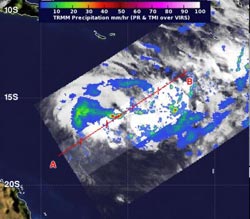NASA's TRMM satellite sees Tropical Cyclone 19P form

NASA's TRMM satellite captured a look at the rainfall rates within System 92P on March 7 at 0023 UTC (March 6 at 7:23 p.m. EST) hours before it became a tropical cyclone. Red areas indicate heavy rain, falling at a rate of 2 inches/50 mm per hour. Green and blue areas indicate moderate rainfall.<br><br>Credit: NASA/SSAI, Hal Pierce<br>
NASA's TRMM satellite captured a look at the rainfall rates within low pressure System 92P on March 7 at 0023 UTC (March 6 at 7:23 p.m. EST), just hours before it became Tropical Cyclone 19P (TC 19P). TRMM data indicated that heavy rain was falling at a rate of 2 inches/50 mm per hour around the center of circulation, and that some of the thunderstorms were powerful as they topped heights of 9.3 miles (15 kilometers). Bands of thunderstorms around the storm expanded, strengthened and wrapped tighter around the storm's center today, March 7, according to the Joint Typhoon Warning Center (JTWC).
On March 7 at 1200 UTC (7 a.m. EST) the intensifying tropical storm had maximum sustained winds near 35 knots (40 mph/64 kph). TC 19P was centered near 15.4 south latitude and 156.9 east longitude about 660 nautical miles (759.5 miles/1,222 km) northwest of Noumea, New Caledonia. TC19P was moving to the east-northeast at 11 knots (12.6 mph/20.3 kph).
JTWC forecasters expect TC 19P to strengthen and curve to the southeast, affecting New Caledonia by March 11.
Media Contact
More Information:
http://www.nasa.govAll latest news from the category: Earth Sciences
Earth Sciences (also referred to as Geosciences), which deals with basic issues surrounding our planet, plays a vital role in the area of energy and raw materials supply.
Earth Sciences comprises subjects such as geology, geography, geological informatics, paleontology, mineralogy, petrography, crystallography, geophysics, geodesy, glaciology, cartography, photogrammetry, meteorology and seismology, early-warning systems, earthquake research and polar research.
Newest articles

Properties of new materials for microchips
… can now be measured well. Reseachers of Delft University of Technology demonstrated measuring performance properties of ultrathin silicon membranes. Making ever smaller and more powerful chips requires new ultrathin…

Floating solar’s potential
… to support sustainable development by addressing climate, water, and energy goals holistically. A new study published this week in Nature Energy raises the potential for floating solar photovoltaics (FPV)…

Skyrmions move at record speeds
… a step towards the computing of the future. An international research team led by scientists from the CNRS1 has discovered that the magnetic nanobubbles2 known as skyrmions can be…




















